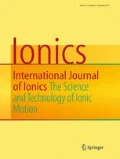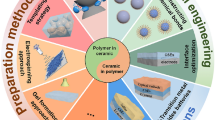Abstract
LiFePO4 (LFP) has been recommended as a promising cathode material due to its excellent cycle performance and high safety. However, the poor performance of low temperatures restricts the development and application of LFP cathode. Herein, the electrochemical properties of the previously synthesized LFP/C-P composite with carbon coating and phosphorus doping are discussed in the low temperature. In the low-temperature environment of − 40 °C, the first discharge-specific capacity of the LFP/C-P composite cathode at 0.1 C can reach 82.7 mAh g−1, while discharge-specific capacity of pristine commercial LFP is only 72.2 mAh g−1. To further improve the electrochemical performance of LFP/C-P at low temperatures, different charging-discharging methods were compared. It is noted that prolonging the constant voltage charging time can further improve the electrochemical performance of the cell, which increases the discharge capacity of LFP/C-P to 85.8 mAh g−1. The LFP/C-P composite cathode therefore not only ameliorates the poor electrochemical performance of LFP but provides a new way to broaden its application range.










Similar content being viewed by others
References
Fathollahi F, Javanbakht M, Omidvar H et al (2015) Improved electrochemical properties of LiFePO4/graphene cathode nanocomposite prepared by one-step hydrothermal method. J Alloys Compd 627:146–152
Fischer MG, Hua X, Wilts BD, Castillo-Martínez E, Steiner U (2018) Polymer-templated LiFePO4/C nanonetworks as high-performance cathode materials for lithium-ion batteries. ACS Appl Mater Interfaces 10:1646–1653
Xiong QQ, Lou JJ, Teng XJ et al (2018) Controllable synthesis of N-C@LiFePO4 nanospheres as advanced cathode of lithium ion batteries. J Alloys Compd 743:377–382
Wang F, Chen J, Tan Z et al (2014) Low-temperature electrochemical performances of LiFePO4 cathode materials for lithium ion batteries. J Taiwan Inst Chem Eng 45:1321–1330
Li J, Wen W, Xu G et al (2015) Fe-added Fe3C carbon nanofibers as anode for Li ion batteries with excellent low-temperature performance. Electrochim Acta 153:300–305
Liu J, Lin X, Han T et al (2018) A novel litchi-like LiFePO4 sphere/reduced graphene oxide composite Li-ion battery cathode with high capacity, good rate-performance and low-temperature property. Appl Surf Sci 459:233–241
Ji H, Zhang L, Pettes MT, Li H, Chen S, Shi L, Piner R, Ruoff RS (2012) Ultrathin graphite foam: a three-dimensional conductive network for battery electrodes. Nano Lett 12:2446–2451
Cai G, Guo R, Liu L et al (2015) Enhanced low temperature electrochemical performances of LiFePO4/C by surface modification with Ti3SiC2. J Power Sources 288:136–144
Li S, Li X, Liu J et al (2015) A low-temperature electrolyte for lithium-ion batteries. Ionics 21:901–907
Zhao Q, Zhang Y, Tang F et al (2017) Mixed salts of lithium difluoro (oxalate) borate and lithium tetrafluorobotate electrolyte on low-temperature performance for lithium-ion batteries. J Electrochem Soc 164:A1873–A1880
Li J, Yuan CF, Guo ZH et al (2012) Limiting factors for low-temperature performance of electrolytes in LiFePO4/Li and graphite/Li half cells. Electrochim Acta 59:69–74
Rui XH, Jin Y, Feng XY et al (2011) A comparative study on the low-temperature performance of LiFePO4/C and Li3V2(PO4)3/C cathodes for lithium-ion batteries[J]. J Power Sources 196:2109–2114
Zeng LJ, Gong Q, Liao XZ et al (2011) Enhanced low-temperature performance of slight Mn-substituted LiFePO4/C cathode for lithium ion batteries. Chin Sci Bull 56:1262–1266
Zhao N, Li Y, Zhao X et al (2016) Effect of particle size and purity on the low temperature electrochemical performance of LiFePO4/C cathode material. J Alloys Compd 683:123–132
Tong B, Wang J, Liu Z et al (2018) Identifying compatibility of lithium salts with LiFePO4 cathode using a symmetric cell. J Power Sources 384:80–85
Johnson ID, Ashton TE, Blagovidova E et al (2018) Mechanistic insights of Li+ diffusion within doped LiFePO4 from Muon Spectroscopy. Sci Rep 8:4114–4120
Wu G, Liu N, Gao X et al (2018) A hydrothermally synthesized LiFePO4/C composite with superior low-temperature performance and cycle life. Appl Surf Sci 435:1329–1336
Li C, Xie Y, Zhang N et al (2018) Optimization of LiFePO4 cathode material based on phosphorus doped graphite network structure for lithium ion batteries. Ionics 25:927–937
Ma X, Wu X, Shen P (2018) Rational design of Na4Fe3(PO4)2(P2O7) nanoparticles embedded in graphene: toward fast sodium storage through the pseudocapacitive effect. ACS Appl Energy Mater 1:6268–6278
Raj H, Sil A (2018) Effect of carbon coating on electrochemical performance of LiFePO4 cathode material for Li-ion battery. Ionics 24:2543–2553
Peng J, Lei Y, Xiang M et al (2018) Facile synthesis of bowl-like LiFePO4/C composite with high rate-performance. J Electron Mater 47:3543–3551
Sánchez L, Anseán D, Otero J et al (2018) Assessing the health of LiFePO4 traction batteries through monotonic echo state networks. Sensors 18:9
Liu Q, Liu Y, Yang F, He H, Xiao X, Ren Y, Lu W, Stach E, Xie J (2018) Capacity fading mechanism of the commercial 18650 LiFePO4-based lithium-ion batteries: an in situ time-resolved high-energy synchrotron XRD study. ACS Appl Mater Interfaces 10:4622–4629
Jinli Z, Jiao W, Yuanyuan L et al (2015) High-performance lithium iron phosphate with phosphorus-doped carbon layers for lithium ion batteries. J Mater Chem A 3:2043–2049
Zhang Y, Alarco JA, Best AS et al (2018) Re-evaluation of experimental measurements for the validation of electronic band structure calculations for LiFePO4 and FePO4. RSC Adv 9:1134–1146
Mondal A, Kaupp M (2018) Quantum-chemical approach to NMR chemical shifts in paramagnetic solids applied to LiFePO4 and LiCoPO4. J Phys Chem Lett 9:1480–1484
Yuan Y, Wang B, Song R et al (2018) A LiFePO4/Li2S n hybrid system with enhanced Li-ion storage performance. New J Chem 42:6626–6630
Latif C, Negara VSI, Wongtepa W et al (2018) Fe K-edge X-ray absorption near-edge spectroscopy (XANES) and X-ray diffraction (XRD) analyses of LiFePO4 and its base materials. J Phys Conf Ser 985:012021
Zeng H, Gu Y, Teng G, Liu Y, Zheng J, Pan F (2018) Ab initio identification of the Li-rich phase in LiFePO4. Phys Chem Chem Phys 20:17497–17503
García G, Dieckhöfer S, Schuhmann W et al (2018) Exceeding 6500 cycles for LiFePO4/Li metal batteries through understanding pulsed charging protocols. J Mater Chem A 6:4746–4751
Asakura D, Nanba Y, Makinose Y, Matsuda H, Glans PA, Guo J, Hosono E (2018) Large charge-transfer energy in LiFePO4 revealed by full-multiplet calculation for the Fe L3-edge soft X-ray emission spectra. ChemPhysChem 19:988–992
Jung S, Jung H (2016) Charge/discharge characteristics of Li-ion batteries with two-phase active materials: a comparative study of LiFePO4 and LiCoO2 cells. Int J Energy Res 40:1541–1555
Jokar A, Désilets M, Lacroix M et al (2018) Mesoscopic modeling and parameter estimation of a lithium-ion battery based on LiFePO4/graphite. J Power Sources 379:84–90
Zhang F, Geng T, Peng F et al (2019) New insights for the abuse tolerance behavior of LiMn2O4 under high cut-off potential conditions. ChemElectroChem 6:731–740
Li Y, Wang C, Gong J (2018) A wavelet transform-adaptive unscented Kalman filter approach for state of charge estimation of LiFePO4 battery. Int J Energy Res 42:587–600
He L, Zha W, Chen D (2018) Crystal growth kinetics, microstructure and electrochemical properties of LiFePO4/carbon nanocomposites fabricated using a chelating structure phosphorus source. RSC Adv 8:3151–3160
Yang CC, Jang JH, Jiang JR (2016) Study of electrochemical performances of lithium titanium oxide–coated LiFePO4/C cathode composite at low and high temperatures. Appl Energy 162:1419–1427
He L, Zha W, Chen D (2017) Effects of organic phosphorus acid on the core-shell structure and electrochemical properties of LiFePO4 uniformly wrapped with in-situ growed graphene nanosheets. J Alloys Compd 727:948–955
Yamanaka T, Abe T, Nishio K et al (2018) Diffusion of Li-deficient phases in large LiFePO4 single crystals during chemical delithiation. J Mater Chem A 6:11005–11011
Acknowledgments
This work is supported by the Major Science and Technology Projects in Gansu Province (17ZD2GC011), the High-Value Patent Conversion Implementation project (18ZC1LA014), the Transformation of Scientific and Technological Achievements of Gansu Institutions of Higher Education (No. 2017D-04), and the Lanzhou University of Technology Hongliu First-class Discipline Construction Program.
Author information
Authors and Affiliations
Corresponding author
Additional information
Publisher’s note
Springer Nature remains neutral with regard to jurisdictional claims in published maps and institutional affiliations.
Rights and permissions
About this article
Cite this article
Cui, X., Tuo, K., Xie, Y. et al. Investigation on electrochemical performance at the low temperature of LFP/C-P composite based on phosphorus doping carbon network. Ionics 26, 3795–3808 (2020). https://doi.org/10.1007/s11581-020-03567-9
Received:
Revised:
Accepted:
Published:
Issue Date:
DOI: https://doi.org/10.1007/s11581-020-03567-9




